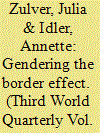| Srl | Item |
| 1 |
ID:
186954


|
|
|
|
|
| Summary/Abstract |
Interregional housing price comovement is a stylized fact worldwide. This study explores how it is affected by administrative division adjustment. We exploit city-county mergers in China as a quasi-natural experiment to construct a difference-in-differences strategy for causal identification. Based on monthly housing price data for districts (counties) in China from 2010 to 2019, we find that city-county mergers significantly improve correlations in housing prices between the merged county and the urban district. This effect is more obvious in cities with a large economic gap between merged counties and urban districts, located in the central and western regions, and with lower administrative hierarchies (non-provincial-capital cities). The mechanism test shows that the impact of city-county mergers on housing price comovement results mainly from integrating housing demand rather than integrating housing supply, like the unified land supply policy that local government implements in the new administrative scope after mergers. The results are helpful in understanding housing price comovement from the view of regional integration and provide clear policy implications for housing market regulation in China.
|
|
|
|
|
|
|
|
|
|
|
|
|
|
|
|
| 2 |
ID:
171934


|
|
|
|
|
| Summary/Abstract |
In the Colombian–Venezuelan borderlands, the reconfiguration of armed group presence and mass migration create and reinforce conditions of high violence and risk. Against this backdrop, we ask: What are the gendered security implications of the double crisis in the borderlands? Based on fieldwork in four regions along the border, this article argues that the border effect is gendered; the very factors that coalesce to produce this effect exacerbate existing gendered power dynamics, particularly as these relate to gender-based violence. Accordingly, this article demonstrates the specific ways in which the border – as a facilitator, deterrent, magnet and/or disguise – reinforces experiences of gendered insecurity in this region. The article finishes by outlining the implications for other international borderland settings.
|
|
|
|
|
|
|
|
|
|
|
|
|
|
|
|
| 3 |
ID:
161772


|
|
|
|
|
| Summary/Abstract |
Using a representative sample of rural migrants in cities, this paper investigates where the migrants in urban China come from, paying close attention to intra-provincial vs. inter-provincial migrants, and examining the differences in their personal attributes. We find that migrants who have come from within the province differ significantly from those who have come from outside of the province. Using a nested logit model, we find that overall, higher wage differentials, larger population size, higher GDP per capita, and faster employment growth rate are the attributes of a city that attract rural-to-urban migrants. In addition, moving beyond one's home province has a strong deterrent effect on migration, analogous to the “border effect” identified in international migration studies. We also explore the role of culture, institutional barriers, and dialect in explaining such a pronounced “border effect”.
|
|
|
|
|
|
|
|
|
|
|
|
|
|
|
|